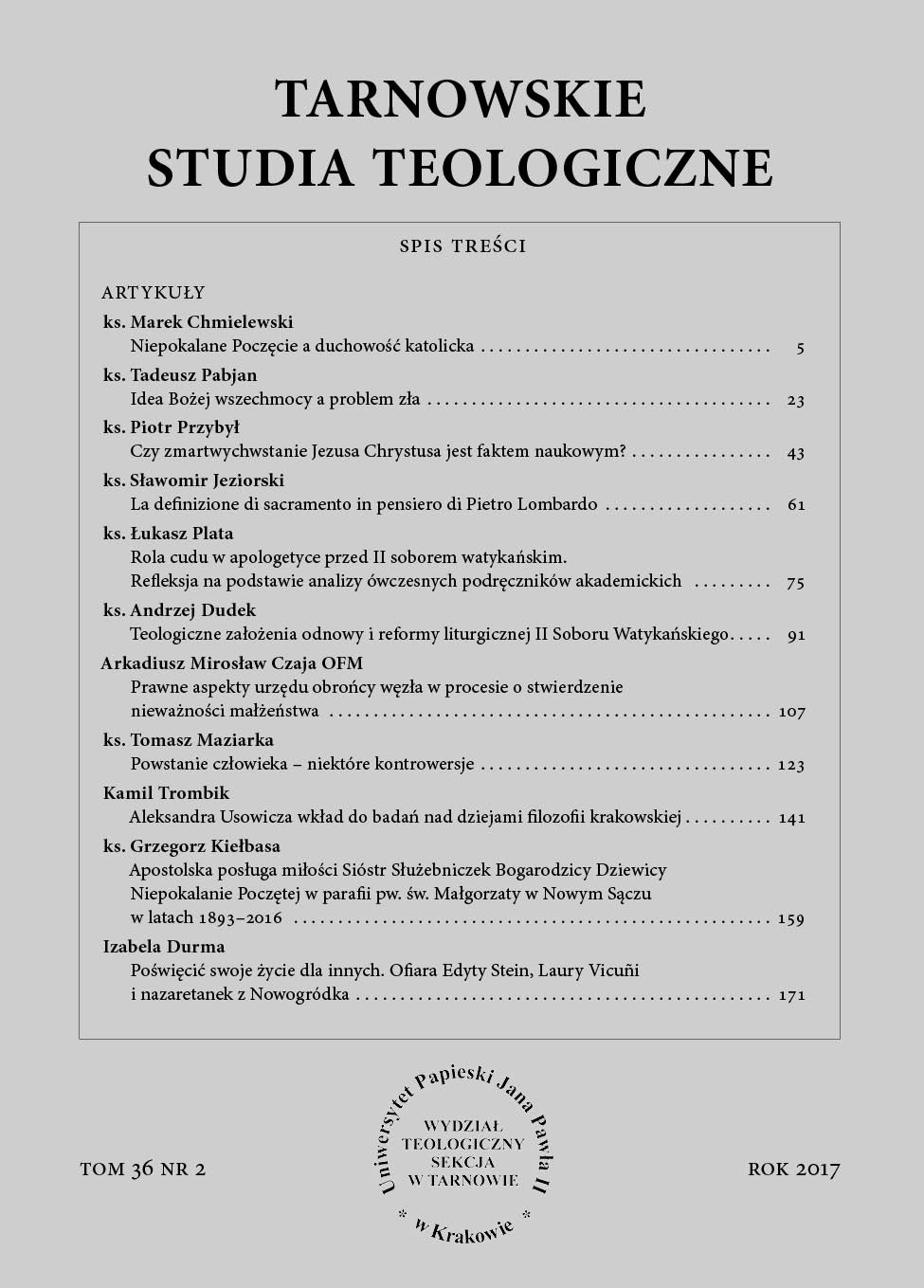The Definition of “Sacrament” in Peter Lombard’s Thought
DOI:
https://doi.org/10.15633/tst.2615Keywords:
Peter Lombard, liturgy, sacrament, similarit, , sing, causality, formAbstract
The Sentences of Peter Lombard had a big influence on medieval theological thought. So, Lombard’s definition of the sacrament is not without meaning for theology. This article is an attempt to explain the concept that became a basis of systematisation of the seven sacrament of the Catholic Church. For this reason, the article begins with the historical-cultural context of Lombard’s ideas. On this landscape, the definition of a sacrament is examined, starting with literal analysis along with theological insights. The theological explanations contains a description of sign, causality, similarity and form of sacrament.
References
Augustinus, De doctrina christiana, ed. J. Martin (Corpus Christianorum. Series Latinae, 32), Turnhout 1962.
Bourgeols H., I segni della salvezza, vol. 3: 12-20 secolo: sacramenti e Chiesa, Vergine Maria, Casale Monferrato 1998.
Brovelli F., La prassi liturgica nelle diverse epoche culturali, in: Celebrare il mistero di Cristo, vol. 2: La celebrazione dei sacramenti, a cura di G. Bonaccorso, Roma 1996, p. 172–228.
Caprioli A., Alle origini della „definizione” di sacramento, „La scuola cattolica” 102 (1974), p. 718–743.
Caprioli A., La riflessione teologica sui sacramenti in età medioevale, in: Celebrare il mistero di Cristo, vol. 2: La celebrazione dei sacramenti, a cura di G. Bonaccorso, Roma 1996, p. 281–301.
Cattaneo E., Il culto cristiano in Occidente. Note storiche (Biblioteca Ephemerides Liturgicae. Subsidia, 13), Roma 20032.
Colish M., Peter Lombard, Leiden–New York–Köln 1994.
Marmo C., Segno e immagini nelle „Sententiae” di Pietro Lombardo, in: Pietro Lombardo. Atti del XLIII Convegno storico internazionale (Todi, 8–10.10.2006), a cura di E. Menestò, Spoleto 2007, p. 51–88.
Mazza E., La celebrazione eucaristica. Genesi del rito e sviluppo dell’interpretazione, Bologna 2003.
Mazza E., Continuità e discontinuità. Concezioni medievali dell’eucaristia a confronto con la tradizione dei Padri e della liturgia (Biblioteca Ephemerides Liturgicae. Subsidia, 113), Roma 2001.
Mazza E., Elementi agostiniani necessari per la concezione sacramentale della liturgia, in: Per ritus et preces. Sacramentalità della liturgia. Atti VIII Congresso Internazionale di Liturgia (Roma, Pontificio Istituto Liturgico, 16–18.05.2007), a cura di P. A. Muroni, Roma 2010, p. 45–86.
Neunheuser B., Storia della liturgia attraverso le epoche culturali (Biblioteca Ephemerides Liturgicae. Subsidia, 11), Roma 19993.
Nielsen O. L., Peter Lombard in the Teological Context of the 12th Century: the Theological Virtue of Charity, in: Pietro Lombardo. Atti dell XLIII Convegno storico internazionale (Todi, 8–10.10.2006), a cura di E. Menestò, Spoleto 2007, p. 411–432.
Petrus Lombardus, Sententiae in IV libris distinctae, tomus II: Liber III et IV, Grottaferrata 1981.
Ruffini E., Sacramenti, in: Dizionario teologico interdisciplinare, a cura di L. Pacomio, vol. 3, Torino 1977, p. 184–201.
Sartore D., Segno/simbolo, in: Liturgia, a cura di D. Sartore, A. M. Triacca, C. Cibien, Cinisello Balsamo 2001, p. 1853–1864.
Sierra López J. M., El número septenario de los sacramentos, in: Asociación Española de Profesores de Liturgia, La sacramentalidad de la liturgia, Barcelona 2010, p. 109–141.
Van Den Eynde D., Les définitions des sacrements pendant la première période de la théologie scolastique, „Antonianum” 34 (1949), p. 183–228.
Downloads
Published
Issue
Section
License
Authors who publish with this journal agree to the following terms:
- Authors retain the copyright and full publishing rights without restrictions, and grant the journal right of first publication with the work simultaneously licensed under a Creative Commons Attribution 4.0 International License that allows others to share the work with an acknowledgement of the work's authorship and initial publication in this journal.
- Authors are able to enter into separate, additional contractual arrangements for the non-exclusive distribution of the journal's published version of the work (e.g., post it to an institutional repository or publish it in a book), with an acknowledgement of its initial publication in this journal.
- Authors are permitted and encouraged to post their work online (e.g., in institutional repositories or on their website) prior to and during the submission process, as it can lead to productive exchanges, as well as earlier and greater citation of published work (See The Effect of Open Access).

